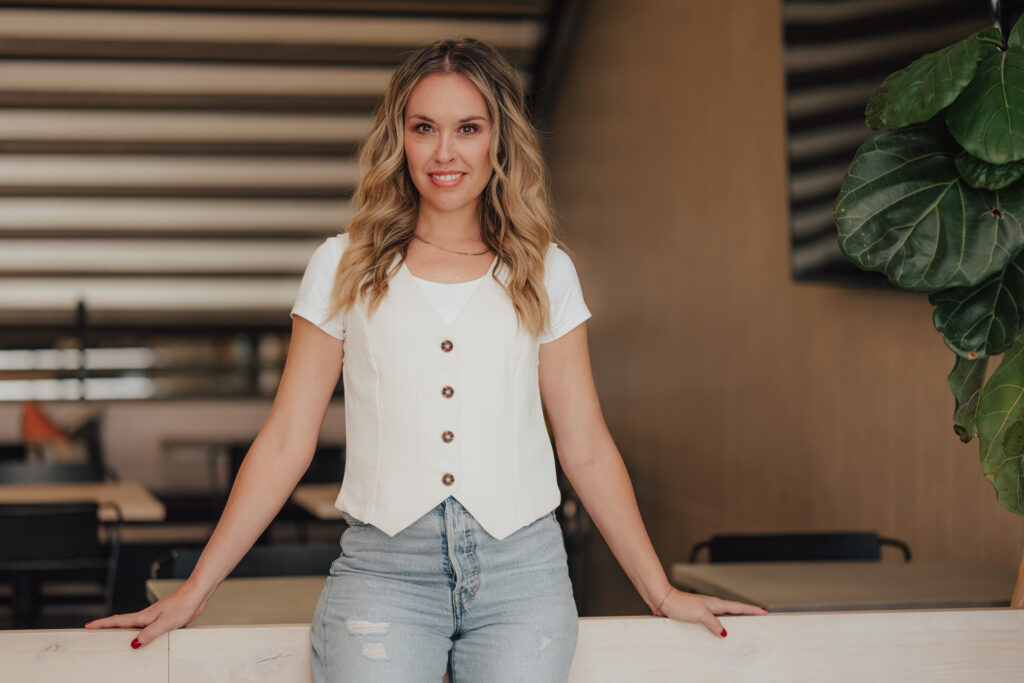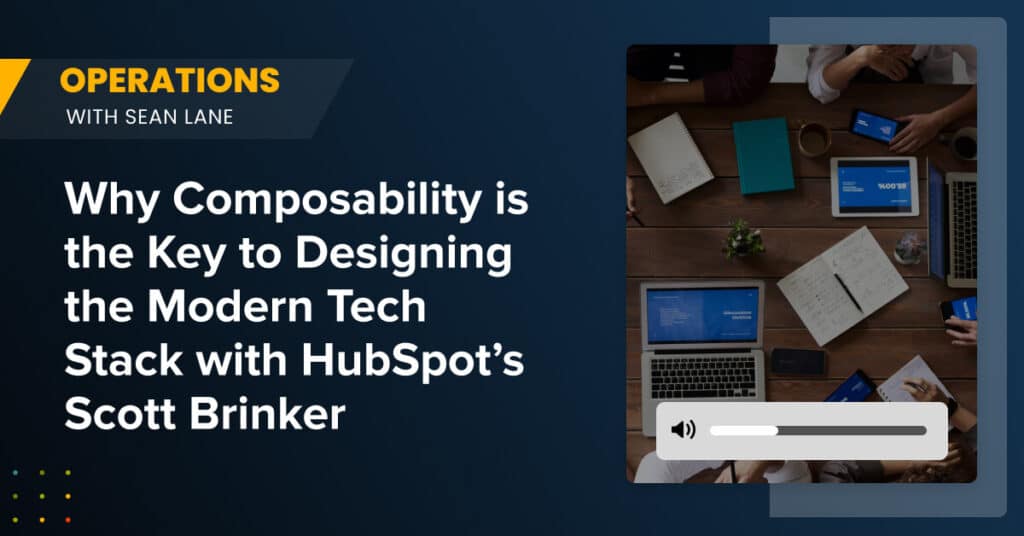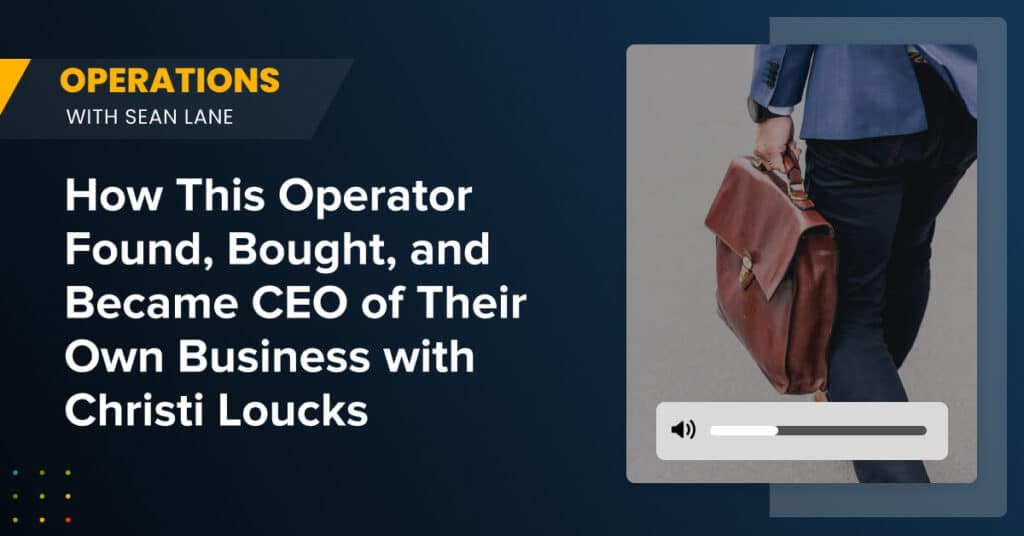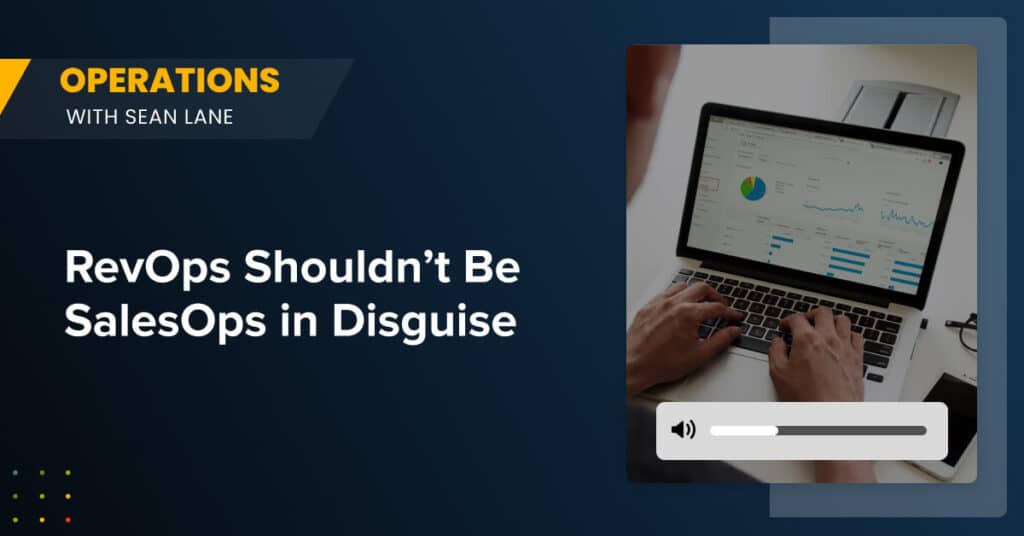RevOps as a Philosophy
Overview
- What does RevOps mean to you and what are the components of that philosophy? [1:26]
- What does RevOps look like in different organizations? Where do you start? [4:34]
- Examples of this philosophy in play when there are unexpected changes in the market [8:52]
- How do you implement this philosophy into your company? [12:33]
- How can this philosophy foster adaptability and resilience in an organization? [17:45]
- How would you go about implementing some kind of program to build this mobility aspect? [19:54]
- How does all this philosophy play into facilitating these large scale go to market changes? [21:39]
- Final Thoughts [27:33]
Introductions
Tyler
Hello, everybody. Thank you for joining us today for Fullcast’s Fireside Chat. Today’s topic is “RevOps as a Philosophy”, and our guest is Abhi Ingle. Why don’t we take a couple of seconds here and have Abhi introduce himself and tell us what you’re doing at Qualtrics.
Abhi
Thank you, Tyler. I’m Abhi Ingle. I am the head of revenue operations, presales and industry at Qualtrics. I’ve been here for just over a year, so I joined at an exciting time. The company has gone public, made three acquisitions. So RevOps has been hard at work over the year. Prior to that, I used to be the head of digital, product and various different functions at AT&T. And prior to that, I was a CMO at a couple of Silicon Valley companies. Started off my career at the McKinsey & Company. I’m super excited to be here and share some thoughts with you.
Tyler
Wonderful. I know we’ve got 28 minutes to compact a really big topic, and you and I were talking a little bit before this call, and there’s a lot to cover. So I do want to jump in and get started. My favorite way to start these things is to give you the broadest question possible, and then we’ll figure out where it goes from there.
What does RevOps mean to you and what are the components of that philosophy? [1:26]
So we’re talking about “RevOps as a Philosophy”. So, what does “RevOps as a Philosophy” mean to you? And maybe what are some of the components as a part of that philosophy?
Abhi
Let’s just break those up. Because I think a lot of people struggle with “is revenue operations possible” at a company when you’re not organized in that format. And what I’m going to posit today is revenue operations is a philosophy. It’s a mindset as well as an organization, and you can actually execute one without being necessarily organized that way. So in the most formal way, “revenue operations can be a formal organization which encompasses the previously separate domains of sales operations, marketing operations, and CS operations housed under one roof.” That’s the formal definition of revenue operations per se.
Or it can be a philosophy that takes a look at the operations involved with everything to do with revenue and ensures that those three organizations act in harmony around those key revenue objectives. And it’s not just revenue objectives. These are all operational metrics I’ve talked about. There are also experience metrics around that. Right. And I come from an experience management company, so it would be remiss for me not to mention that because at the end of the day, understanding how your customers are experiencing your company, holistically, is critical. Experience drives buying, renewal and upsell opportunities. And capturing that signal and turning that data into insights is critical to keeping your customers loyal.
Similarly, understanding how to optimize the experience of your employees. And in this situation, all the employees interacting with customers is going to be important because their wellbeing and engagement is going to drive your customer experience. So philosophically, we also say that our mission is to “make sure that you design and improve the customer and sales and revenue team experience to accelerate revenue”.
Then I get into the operational metrics that you talked about. So how do you do that? Kind of think about it as people, data, and process. And one thing I’ll start off by saying is “decision making has to be driven by data”, and they have to be single sources of truth. If you don’t have decision making, culture and philosophy driven by, “let’s look at the data”, and you don’t have people looking at the same sets of data, which means that your systems in your process need to be interconnected, then it’s very hard to get to an objective cross revenue decision. So making sure your people are aligned around a single view of the business with shared revenue targets. You want to make sure their goals are aligned to data, connecting the business and activity data across the different organizational technology and operational styles.
And then for processes, you got to have integrated cadences, where people come together to look at the customer holistically. “What’s a healthy customer?”, for example. “What are the metrics? What roles does sales have in that? What roles does CS have in that?” Getting some agreement around that and how we measure it. So that would be my overall perspective on the two questions that you asked me.
What does RevOps look like in different organizations? Where do you start? [4:34]
Tyler
Now, how do they play out in different organizations? So I actually like to talk about the inflection point of you’re starting to grow and RevOps is really becoming a thing. And a lot of people understand the operational side of things, right? Where we just went through, like the data and making data driven decisions, putting together processes. But layering in this experience piece as an organization that’s growing, how do you begin to start to think about, like doing that? Where do you start?
Abhi
Right. So if you think about your customer journey, that’s the best way to think, customer journey or a buyer journey, whatever you want to call it. I call it a buyer journey because some of them are not your customers yet. And it starts in the marketing function in terms of how you’re interacting with somebody. What are the ways in which you’re reaching out that they turn into a lead, a sales qualified lead and then actually talk to them and turn to a customer?
Then, you actually have CS work with them. If you think about that customer journey, there are oftentimes multiple people touching that person. It could be a marketing communications, it could be an SDR, it could be an AE, an account executive, it could be a CS person, it could be an implementation person. How do you make sure that you understand the holistic journey that your customer or buyer goes through in that process? Super important for you to gauge that. We obviously use that using Qualtrics’ experience management software, but making sure you understand that journey and optimize it, so you understand how to pivot based on what a customer is experiencing.
The second one is making sure that the employees who are touching that customer have what they need. Very simply, are you surveying your sales team to figure out what prevents them from being effective and serving your customers effectively? I’ll give you a specific example.
We got some feedback from our customers that “love the way your sales team engaged with us. So excited with the technology demos. When it came down to getting a quote, it seemed to take a lot of time.” When we went back and look at the employee side, and the first three issues that we saw, it was quoting, quoting, quoting. Why? Because our systems weren’t interconnected. The different departments that touched that were not doing that. So we got signal from customers, but we had to go and get signal from employees. When we actually resolved that, that basically boosted our employee productivity. Their satisfaction would also help customers significantly. That’s a very specific example of that area. On the CS side, we look at different metrics, such as does the CS team have the tools that they need to service their customers.
Do they have the advanced reports that give them “what is a healthy customer, what drives them? What kind of predictive data can you give them?” So these are the kind of things that we look at that are very specific examples. Hopefully, that gives you a sense of what we look at.
Tyler
Does it change? I mean, you’ve been in companies that are a little bit larger than some of these startups. Does it change when you get up to the scale that you’ve been at with Qualtrics and things like that? Do you look at different things?
Abhi
100%. It’s not just you look at different things, you start getting more automation in your processes, and that’s one of the things for a revenue operations team to look at. At Qualtrics, one of our values is being scrappy. And I think of scrappy as a way to take action quickly and move on something. It’s a bias towards action, right?
But after you scrappy something, if you realize it’s working, think of it as almost like an MVP, like a minimum viable product to get into market. At some point, if you’re doing that 100 times over and your team goes from like five people using a scrappy process to 200 people, 300 people. That process starts to really actually turn from scrappy into kind of crappy. You do not want to be there. So you’re going from scrappy to scale, never from scrappy to crappy.
What are some examples of this philosophy in play? [8:52]
Tyler
I love it. I hope we can quote that later. It’s going to be the marquee. So let’s talk about some examples here of how this philosophy comes into play when maybe we have some unexpected changes in the market.
Abhi
I think real world examples are right. So I’ll take a real world example of something we are all, frankly experiencing, and I’ll just start by saying that I hope everybody is keeping healthy and you’re taking care of yourself and your families, even as you do your job, because it’s a really important time for us to watch out for each other. There are a lot of people who are struggling right now with the pandemic.
So as you recall, last year, we had rolling series of disruptions to companies and to consumers caused by how the pandemic progressed. And one of the turning points was as a mandate came down, requiring companies to be compliant with that particular testing status and testing that was required. Either you show your status that you’re vaccinated or before you come, in you test. How do you keep on top of that? There was like a $20,000 fine being imposed by the government on companies above a certain size if you’re not compliant. That’s a pretty big hit if you add it up. And there are all kinds of different fines and things of that nature. So Qualtrics is experience management as a platform. We very quickly pivoted, and we realized that our industry team got signaled that the government was going in this direction.
It was going to come for government first. So they came to us as an industry specific signal because we’re constantly keeping on top of what our customers are looking for, right? We use our own software for that. And we quickly jumped in our platforms and we created a solution that would allow companies to both ensure the safety and wellbeing of their employees and insurance compliance, which means they’ll be compliant. They will save money and they’ll make that happen. Now, that was not something that was planned. It’s not in the budget, it’s not in the campaign flow. It’s not in the sales training. It’s not in the CS talk track. What the heck do you do?
And the company just totally turned on a dime. We changed our messaging. We changed our targeting. So we targeted the right customers. For example, there wasn’t a mandate on this in overseas companies, but there was in the United States, so we were very focused. We had to change the campaigns, change the messaging, change the training for only those employees in those areas from a sales perspective and have the ability to be able to coordinate them and then actually implement it.
How do you implement a new solution that came out? You don’t have the partners, you have to change your implementation teams, you have to train your partners. If we had not done that in a holistic manner, we would have had marketing changing tack, targeting the right customers, sales people going into the tone deaf earlier track. That wouldn’t make sense. And then implementation resources not lined up to address the fact that we have a new solution on the market. That had to be done in a very interconnected manner. We need to have the data to say, if you’re going to pivot away from an existing planned campaign, is the juice worth the squeeze? Why should we do that?
And if we had not applied that RevOps philosophy, which allowed us to pivot very quickly and address the option to meet customers where they are, which is super important. So without going into any details, let me just tell you, it was a very successful pivot. It is controversial that we made it. It’s controversial that we canned certain planned activities, but it’s been executed incredibly well because our teams have this philosophy of responding to customers and working with each other and being interconnected towards entering that end to end journey.
How do you implement this philosophy into your company? [12:33]
Tyler
This is going to be a dumb question. How do you implement something like this, like this philosophy? I love this idea that if you’ve implemented this, it’s kind of almost part of the culture, right? Like philosophy and culture can kind of be one and the same. But how do you begin to start to change your organization to think about that? Like, how do you go about and implement?
Abhi
I know it comes back to the first principle that I started off with. That’s why I talked about philosophy, I talked about operations and added in experience. If you commit yourself to constantly designing and improving, it’s not a one done situation. To optimize the experience that your customers and your salespeople— or your revenue team more broadly, all the people attached to the customer have — you’re going to hear about these issues? You’re going to hear from employees on these particular topics, and once they feel aligned towards the “optimizing the buyer” journey, that to me is a cultural moment.
If you say that we are obsessed about our customers, it becomes a way of doing business. So if your customers are under the gun in compliance, you are getting signal about that, shouldn’t you do something about it? So you have to kind of drive that. And similarly, remember, if customers are going through this, your employees are also experiencing this. What are you doing to make sure employees feel safe about it? So that is an interconnected element that builds upon each other. But you can’t start when you have the crisis. It’s got to be a way of operating ahead of time and a set of compacts between the teams.
That when something of this sort happens, we hold hands, we make a decision. And that’s why the decision can’t be just an emotion. It has to be done based on data. For that, you need to have the right data sets underneath.
Tyler
I love this theme that I’ve been sticking on with all these Fireside chats, which is talking a little bit about feedback loops, because I want to see if you can just touch on maybe some of the feedback loops you’ve set up to reinforce particularly this philosophy of going after the buyer’s journey and making the customer experience as best as it can be.
Abhi
Absolutely. So, first of all, we live our own software, to some extent. Without trying to turn into a shelf of this. You’re asking me a question about feedback, because that’s what Qualtrics is all about. Fundamentally, we actually have an employee engagement product line, which is very widely adopted, and we use that for our own employees. So on a quarterly basis, we are engaging the engagement, the manager effectiveness. They’re welding around different elements.
There’s a lot of science behind this. We have a philosophy called EX25, which is a scientifically based approach of “what are the four or five things that employees will look for?” That’s with employees. We have another product which actually helps us measure customer NPS. We have products that do, for example, free text analysis. We have products that do conversational analytics when customers call in. So we are constantly getting signal on what’s coming in. And then we have an operating cadence where every morning the executive team of the company gets together and say, “What are we hearing? What’s happening?”, and we talk about that. And then we have operating cadences across sales and product. The specialists in the products and the product teams are talking on a weekly basis.
When you get signal, you act on signal. You say, “oh, I need data on the operations people. What is the size of the opportunity that we’re seeing out here?” So that is an operating rhythm that we have, which is both using our instrumentation to capture signal, get the insights from the signal, but most importantly, take action on the signal.
Tyler
That’s it. I feel like we always are getting signals. Everyone’s always gathering data and doing all that, but you never take the time to actually turn that around and take action on it. And I think what was the key there is that you called that operating cadence or operating rhythm, but it’s making that part of the daily or the weekly thing that you’re going to review these signals and then figure out what to do with them. And I think a lot of people, a lot of companies may miss that part. They’re like, Well, we’re collecting this. We have an MPs score. We’ve got all this information coming in.
Abhi
For us, those things are like big company bets, and we actually have a scorecard on a quarterly basis, we look at these things. It can be formal, it can be informal. But you have to have a way that if you’re going to measure something, you got to talk about it and say “what are you going to do about it?” Don’t just measure for the sake of measurement, that just makes no value. If you want to get something done, you got to measure, both ways.
How can this philosophy foster adaptability and resilience in an organization? [17:45]
Tyler
How can this philosophy maybe lend itself to fostering, let’s say, some adaptability and resilience in an organization?
Abhi
I’ll give you an example of adaptability, so I’m not going to repeat that. But let’s talk about resilience. I think one of the things that employees suffer from within a company is if your goals are not aligned. If you don’t have the same similar objectives then, let’s say, Tyler you and I are talking. I could have an objective that pushed me in this direction, and yours is pushing in that direction. We are pulling upon each other. Unless we have a common, unifying objective, let’s say, “What is your customer experiencing in their buyer journey?” You might be trying to maximize the metric, I might be trying to maximize the metric, but we are really at odds with each other. That actually helps align us. You can always have a discussion on a common goal. So you got to have your own metrics for each Department, but also a common overarching goal, that’s one.
The second thing from a resilience perspective is, let’s just take that example I talked about earlier. Imagine that only the sales operations team or the marketing operations team had the objective of pivoting to that particular area. Imagine how hard it would be for a marketing person to come in and say, “Hey sales, we’re changing your entire training, your entire script right now, and we are pivoting you to focus from this part onto this new platform and product. It will be almost impossible, the amount of stress it would cause for that person who was tasked with it, would be terrible. This allows you to have the resilience, which allows you to know that you’re part of a community of people that you can work with at multiple levels of the company that allow you to implement a change that’s happened.
The third one, I would say, is mobility and the ability to actually rotate through different departments and broaden your skill set. Because in the middle of all of this, you have to think about your employees, learning their development, their career paths, right? And the last thing is, when you actually rotate through different departments, you develop empathy. If I walked a mile in your shoes, I’m a lot more likely to sympathize and empathize with what you experienced saying “oh, that person in CSR, they are the worst, they never understand what we are trying to do in marketing or in sales.”
How would you go about implementing some kind of program to build this mobility aspect? [19:54]
Tyler
Yeah. This is related, but unrelated. I was skiing this weekend and we were on the lift, and we’re talking about how everybody should spend time de-icing a lift because everyone’s pissed off right now because we had so much snow in the northwest that all these lifts are closed and everyone’s like, Why aren’t they open? And it’s like you got to just spend the time digging out a lift and then you’ll understand, you’ll have that empathy for what these people are going through to get things running, and I think that’s huge. So how would you implement something like that? Do you just rotate employees around every year, or is it like opportunities that come up? Is it a forced rotation? How would you go about implementing some kind of program to build this mobility aspect?
Abhi
That’s a complex question that does vary from company to company. There’s three ways I kind of think about doing it. One is to model that behavior for people and say, “this is a very acceptable way.” It’s part of the discussions you have with people. A lot of people look at moving up in the organization, in their particular function, telling them that “you’re more valuable at this level, if you’ve done this level in two different departments,” is one way to do it. Actually choosing people and taking a risk on people who have actually done that. So living it, first saying it, then living it.
Then thirdly, having a system which says “before somebody in CS hires somebody externally, would you make sure that you give a shot to the people who are in other departments who might want to do that? Give them a shot.” So Tyler might not have done CS, but if I know Tyler is a kick-ass marketing person at the front end, maybe we should give Taylor a chance. He’s a known entity, he knows the company. So those three things I think come together to play in how that works out.
How does all this philosophy play into facilitating these large scale go to market changes? [21:39]
Tyler
That’s great. So we got a little bit of time left and my favorite question, which is one of the last questions we have on this list here is just, when we start to think about large scale changes to our go to market. So we’re now thinking about this go to market, we’re going through go to market planning, we’re thinking about maybe putting the pedal down to the floor and really pushing or maybe changing how we’re thinking about allocating sales resources. How does all this philosophy that we’ve talked about up to this point play into facilitating these large scale go to market changes?
Abhi
One of the questions that, Tyler I think you and Ashley had mentioned to me was, you wanted to talk about one of the common things that companies face. Let’s take a specific example, I think that always brings things to life, as opposed to talking generally. How do you decide between a regional go to market, a product, go to market or industry go market? Or let’s say that you’re in a regional market and you’re trying to verticalize your sales team, what happens? So this is a very common question. This is not an uncommon question. It does really require you to martial and actually have a framework for thinking about this in a very systemic manner across the areas. For example, if you’re going to change from a purely regional territory and quota assignment to a vertically driven assignment. The first question is, how many verticals are you going to do? There’s going to be a trade off out there between efficiency versus, what I’ll call, effectiveness. Assume that if somebody has five financial services accounts, they can be better at talking to financial services, no question at all. But if those things are scattered over a big geography, maybe they can’t develop the same relationship that they could have if they were located a little bit closer.
Some of this is becoming a little moot in a virtual environment, but those are important considerations. The other thing is, if in the process of moving from a regional, to a concentrated vertical portfolio, I take my account manager, “I love Tyler. He is the best account manager I’ve ever had. You just took him away from me. What the heck?” You’ve got a balance of disruption versus the ability for Tyler to have similar accounts so you can actually develop that, how do you weigh that off? Those are all data driven discussions that you need to have. Part of that is data driven from the perspective of saying, “how much revenue am I disrupting?” If you’re a startup and you’ve got a really small revenue, it’s easier to do. If you’re a billion dollar company and you’re going to be disrupting accounts worth $250,000,000, you bet this is going to be a discussion with your entire executive team, and maybe you need a board of directors before you shift your people into that area. So you need to be very thoughtful about that particular trade off.
Marketing needs to have a perspective, because what’s the point of putting Tyler in this concentrated revenue? Let’s say you’ve made the investment, you put him into all financial accounts. Do marketing, in your industry team, provide them the content, the expertise, the top track, the specific value that they can provide. If they don’t have it, then why would you take on that disruption? Why would you? So those are very specific things that happen.
Let’s say you sold them the dream, you had the right message. You talked about the business, but then your CS team couldn’t actually deliver the value that you committed to them, how does that help anybody? That’s why when these types of resources change, you have to have a very data driven approach. You weigh off the pros and the cons, and you make sure that, holistically, you are ready to pivot. If you’re not holistically ready to pivot, ask yourself, “Is it worthwhile for me to take on that disruption, If marketing doesn’t have new content, if CS can’t actually fulfill the promise of what your salesperson just promised them?” Why would you do that? Over time, as you get deeper into these vertically specific areas, you need to have a way to get product signals.
Hey, we have learned that on our general purpose platform, if you build these two extensions, we’re going to provide extraordinary value to our healthcare clients. We are actually doing something in healthcare, that’s why I bring it up. We recently bought a company that is going to give us the ability to do surveys that are compliant with what I call the healthcare tax requirements. Now, that’s a survey with a specific methodology that’s a regular survey running on a general purpose platform. That’s a very powerful pivot for us into healthcare. Is that worth pivoting people for? You bet, because you will provide specific value to customers. Specific value to customers. Is that helpful?
Tyler
Yeah I think it is, and really what’s important here is that it, again, goes all the way back to the beginning where we’re talking about these inputs that we’re getting. So we’re getting feedback in different places throughout the buyer’s journey and understanding operating cadence. Reviewing that, and coming out of that might be this decision that, in your example, Healthcare, there’s this opportunity, we can go buy this company or we’ve already purchased the company. We now need to think about aligning not just regionally, but switching that to a vertical approach, because here are all these inputs, here’s all the data that supports doing this and why, and let’s go do that.
Abhi
Exactly.
Tyler
So I think we’re about up on time, and I am out of question, which is actually rare. You’ve done such a wonderful job of explaining everything. I really appreciate it. Actually, we should probably check the chat to see if there’s anything.
Abhi
We can take one last question where everybody has it.
Final Thoughts [27:33]
Tyler
Yeah, if there’s any questions from the group, then we can do one question there. Ashley has just chatted there, so we’ll see, we’ll give 30 seconds or so. Well, I don’t see any questions coming in. So do you have any departing thoughts or any kind of big overarching thing that you’d like to give as closing remark?
Abhi
I’ll just say, remember, RevOps doesn’t need to be an organization for you to act in that manner that takes care of customers, end to end, follow their buying journey, and also thinking about your employees and empowering them. Ask yourself, how are you getting that signal from your customers, from your employees? Are you giving them what they need for your customers to be successful? Do you have the operating cadences? Lastly, I’ll just say, stay safe. It’s a new year. Happy New Year to all of you. I hope you have amazing success this year as you go forward with this new RevOps philosophy. Thank you.
Tyler
Thank you, Abhi. I appreciate you taking the time out of your extremely busy schedule. We all know this is planning season for everyone, so really appreciate it, until next time.
Abhi
Cheers.
Tyler
See you. Bye.








